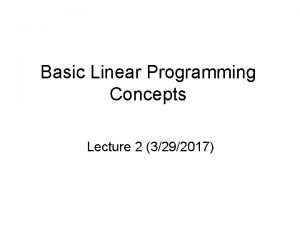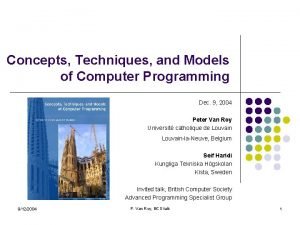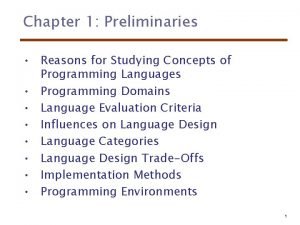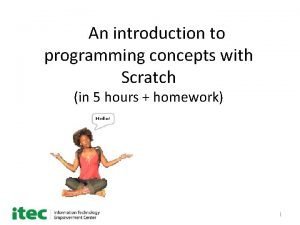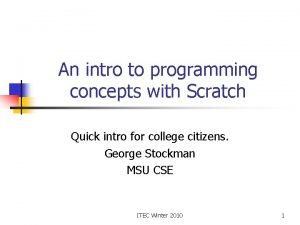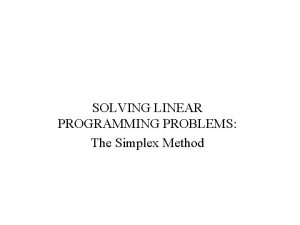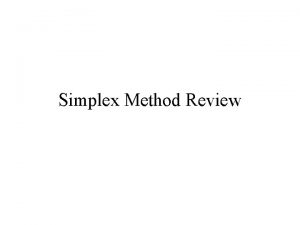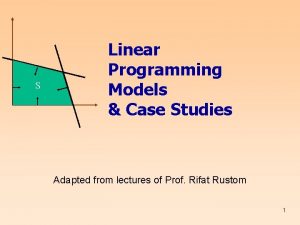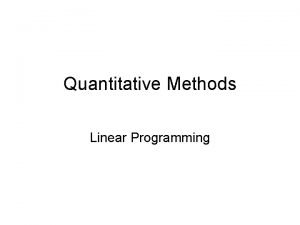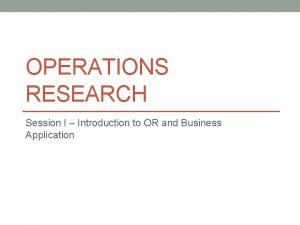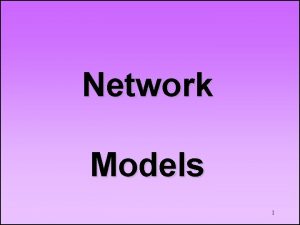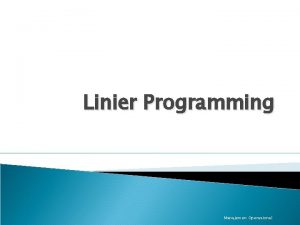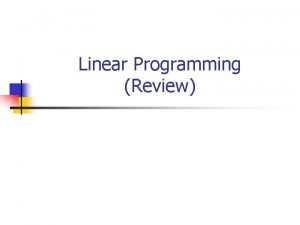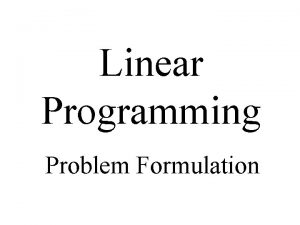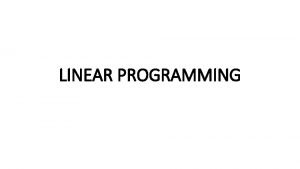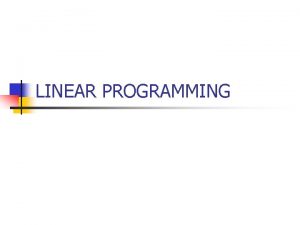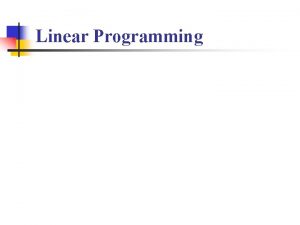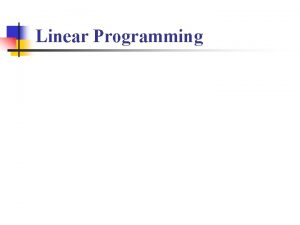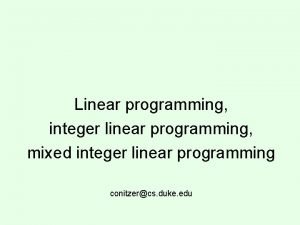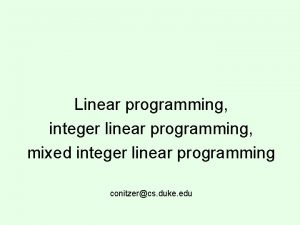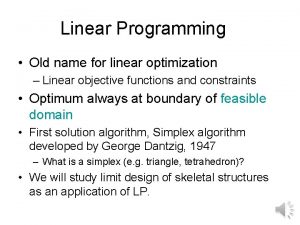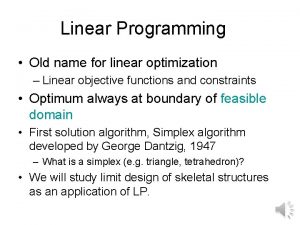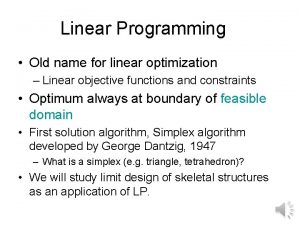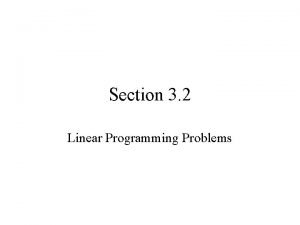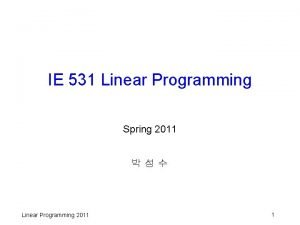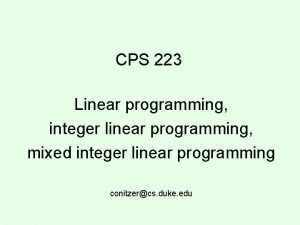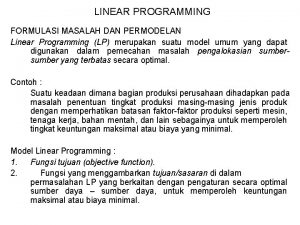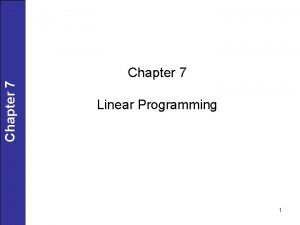Linear Programming Concepts Concepts What is Linear Programming






















- Slides: 22

Linear Programming

Concepts

Concepts What is Linear Programming? Linear programming method is a technique for choosing the best alternative from a set of feasible alternatives, in situations in which the objective function as well as the constraints can be expressed as linear mathematical functions.

Concepts What is a Linear Function? It is a First Degree Polynomial: F(x) OR y = m x + c m (slope) and c (y-intercept) are constants, x is variable. Example: y = 3 x + 5 is a linear function If we assume x = 0, then y = 5 If we assume x = 1, then y = 8 If we assume x = 2, then y = 11

Concepts Properties of Linear Programming Models: § Seek to minimize or maximize § Include constraints or limitations § There must be alternatives available § All equations are linear

Linear Programming Example

Linear Programming Example We have 2 products to make (i. e. : tables and chairs) using limited resources (i. e. : carpentry time and painting time) Decision: How many tables and how many chairs to make? Objective: Maximize profit Constraints: Limited hours available Profit Contribution Tables (per table) Rs. 7 Chairs (per chair) Rs. 5 Hours Available Carpentry Painting 3 hrs. 2 hrs. 4 hrs. 1 hr. 2400 1000 Other Constraints: Make no more than 450 chairs. Make at least 100 tables

Linear Programming Example Decision Variables: T = number of tables to make C = number of chairs to make Tables Chairs Profit Contribution Rs. 7 Rs. 5 Hours Available Carpentry 3 hrs. . 4 hrs. . 2400 Painting 2 hrs. . 1 hr. 1000 Objective Function: (Maximize profit) Maximize 7 T + 5 C Constraints: 3 T + 4 C < 2400 for Carpentry hours 2 T + 1 C < 1000 for Painting hours Other Constraints: C < 450 for Chairs T > 100 for Tables Non Negativity Condition: T, C > 0

Linear Programming Example Writing the Linear Programming Problem… Maximize 7 T + 5 C Subject to 3 T + 4 C < 2400 2 T + 1 C < 1000 C < 450 T > 100 T, C > 0 Profit Carpentry hours Painting hours Maximum Chairs Minimum Tables Non-negativity restriction

Linear Programming Example Graphical Solution* * can only be done in 2 dimensions

Characteristics of Linear Programming Graphical Method • Feasible Region: The set of points that satisfies all constraints • Corner Point Property: An optimal solution must lie at one or more corner points • Optimal Solution: The corner point with the best objective function value is optimal

Graphical Solution Carpentry Constraint Line 3 T + 4 C = 2400 C Infeasible > 2400 hrs. 600 3 T Intercepts (T = 0, C = 600) (T = 800, C = 0) +4 Feasible < 2400 hrs. C= 24 00 0 0 800 T

Graphical Solution C= +1 2 T + 1 C = 1000 2 T Painting Constraint Line C 1000 0 100 600 Intercepts (T = 0, C = 1000) (T = 500, C = 0) 0 0 500 800 T

Graphical Solution Max Chair Line C 1000 C = 450 Min Table Line 600 450 T = 100 Feasible 0 Region 0 100 500 800 T

Graphical Solution 7 T C C= +5 4, 0 Objective 40 Function Line 400 Optimal Point (T = 320, C = 360) 7 T 7 T + 5 C = Profit 500 C= +5 2, 8 C= +5 00 7 T 300 2, 1 200 00 100 0 0 100 200 300 400 500 T

Graphical Solution

Special Situations in Linear Programming

Special Situations in Linear Programming Redundant Constraints: Constraints do not affect the feasible region Example: x < 10 x < 12 The second constraint is redundant because it is less restrictive. Infeasibility: When no feasible solution exists (there is no feasible region) Example: x < 10 x > 15

Special Situations in Linear Programming Alternate Optimal Solutions: When there is more than one optimal solution 10 2 T All points on Red segment are optimal C +2 =2 0 Example: Max 2 T + 2 C Subject to: T + C < 10 T < 5 C< 6 T, C > 0 C 6 0 0 5 10 T

Special Situations in Linear Programming Unbounded Solutions: When nothing prevents the solution from becoming infinitely large Example: Max 2 T + 2 C Subject to: 2 T + 3 C > 6 T, C > 0 f o n o i t c ri e tion D lu so C 2 1 0 0 1 23 T

General Statement of Linear Programming Problems

General Statement of Linear Programming Problems Maximize Subject to Z = c 1 x 1 + c 2 x 2 + c 3 x 3 a 11 x 1 + a 12 x 2 + a 13 x 3 < b 1 a 21 x 1 + a 22 x 2 + a 23 x 3 < b 2 a 31 x 1 + a 32 x 2 + a 33 x 3 < b 3 x 1, x 2 > 0 Objective Function Constraints Non-negative condition where… Z = Profit xj = decision variables cj = profit coefficients / objective function coefficients aij = technological coefficients / constraint coefficients bi = resource values / RHS values
 Linear programming basic concepts
Linear programming basic concepts Perbedaan linear programming dan integer programming
Perbedaan linear programming dan integer programming Integer programming vs linear programming
Integer programming vs linear programming Perbedaan linear programming dan integer programming
Perbedaan linear programming dan integer programming Concepts techniques and models of computer programming
Concepts techniques and models of computer programming Reasons for studying concepts of programming languages
Reasons for studying concepts of programming languages Introduction to programming concepts with scratch
Introduction to programming concepts with scratch It takes 2 seconds to say hi
It takes 2 seconds to say hi Greedy algorithm vs dynamic programming
Greedy algorithm vs dynamic programming Windows 10 system programming, part 1
Windows 10 system programming, part 1 Linear programming
Linear programming Shortest path problem linear programming
Shortest path problem linear programming Simplex
Simplex Linear programming case study examples
Linear programming case study examples Linear programming in quantitative techniques
Linear programming in quantitative techniques Scope of linear programming
Scope of linear programming Network model linear programming
Network model linear programming What is linear programming in management science
What is linear programming in management science Pengertian linear programming
Pengertian linear programming Linear programming word problems
Linear programming word problems Linear programming characteristics
Linear programming characteristics Formulation of lpp examples
Formulation of lpp examples Pengertian linear
Pengertian linear
